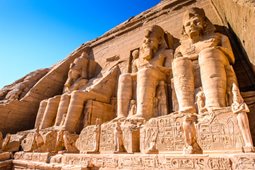
The Egyptian pharaoh Ramses II defeated his Hittite foes at a great battle in 1285 BC. To commemorate this great victory, impress his Nubian neighbors, and glorify his own 67-year reign, Ramses ordered the erection of a magnificent temple on the edge of the Nubian Desert. The facade of this temple featured four immense 65-foot statues of Ramses II crowned with the double crown of Upper and Lower Egypt, and inside the temple, carved deep into a mountain, the corridors were flanked by more towering 20-feet statues of the pharaoh, his prowess in politics and on the battlefield richly illustrated on the walls. The temple’s innermost sanctum contained four life-sized statues of Ramses with the gods Amun-Ra, Ra-Horakhty, and Ptah, the god of the underworld. The temple’s axis was aligned exactly so that twice a year, on February 22 and October 22, a shaft of sunlight would illuminate the statues of Ramses, Amun-Ra and Ra-Horakhty, leaving the god of the underworld shrouded in darkness.
For centuries — even millennia — Ramses’ mighty temple stood as indisputable proof of this greatness. But as the might of Egypt’s empire faded, the sands of the Nubian Desert slowly covered the temple, until even the 65-feet statues of Ramses were hidden. It was only in 1813 that Swiss archeologist Jean Burckhardt re-discovered the temple, helped by young local boy named Abu Simbel who showed Burckhardt the way to the temple. Burckhardt named the monument after the boy, and it quickly became one of the most popular tourist destinations beyond the First Cataract.
Political strife and technology in the twentieth century threatened Abu Simbel once again with a problem that Ramses II would have found baffling. Newly-independent Egypt was desperate to harness the power of the mighty Nile for more reliable irrigation than the ancient rise and fall of the river that made only a narrow strip of land on the river’s banks arable. A hydro-electric dam along the lines of America’s Hoover Dam would not only provide a reservoir of water stretching over 500 kilometers, but would also provide enough electricity for half of the country. Egypt’s controversial Gama Nasser began negotiations with the United States in the mid-fifties to fund the project, but the Eisenhower administration pulled out after the debacle of the Suez crisis and Nasser’s growing alliance with the USSR. Nasser turned to the Soviets, who eagerly stepped in to show off their own engineering might.
The High Dam at Aswan brought the desired progress to Egypt, but put at severe risk some 20 important monuments in Upper Egypt including the jewel in Egypt’s archeological crown: the mighty temple of Abu Simbel. As the waters of the Nile began to rise, a UNESCO-led coalition of archeologists, engineers, and construction workers began to race against time to do the seemingly impossible: dismantle Abu Simbel and move it, block by 20 ton block, 200 meters back from the river’s edge. Some four years later, Ramses’ monument stood once more in front of a newly constructed mountain, still precisely aligned to catch the sun’s shaft twice a year and brilliantly illuminate the three sculptures in the inner sanctum.
Abu Simbel remains one of the world’s most popular tourist destinations today: a true testimony to the ingenuity and vision of the Ancient Egyptians and their modern-day descendants.
Visit Abu Simbel on Alexander + Roberts’ popular Nile cruise itinerary,
Visions of Egypt by Small Ship, always capped at 16 guests to ensure an intimate experience you will treasure!